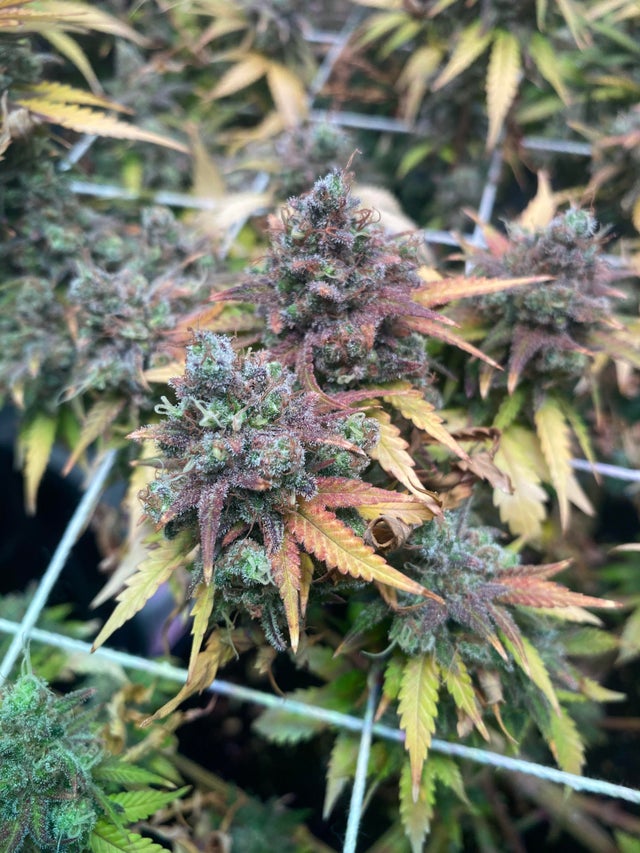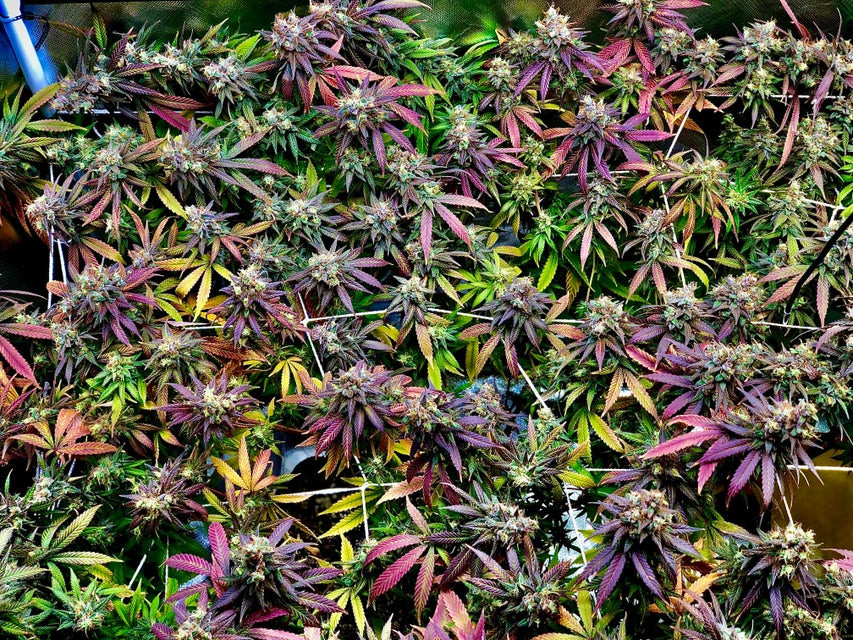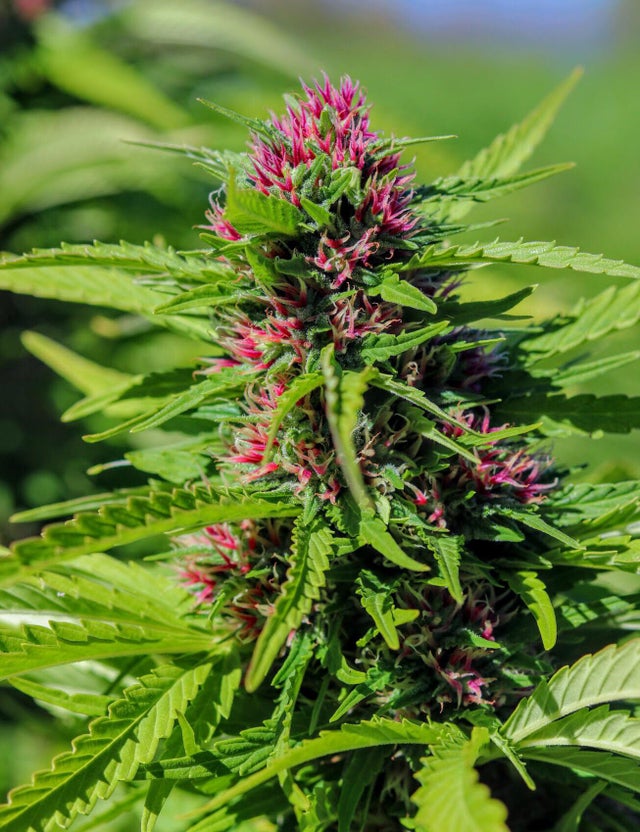Growing Organic Cannabis: Part 10

( Photo Credit: u/IslandChronic Canuk Trainwreck, day 67 of flower )
Soil Conditioners
Similar to nutrients, but not actually nutrients in and of themselves, soil conditioners fill a special spot in the realm of growing organic cannabis.
Soil conditioners can do things like help improve aeration, water drainage, moisture retention properties, as well as aiding plants in the uptake of water and nutrients from the soil.
For the purpose of this article, I'm splitting the idea of soil conditioners into two distinct categories:
- Additives: Anything added to a soil to improve the soil quality
- Conditioners: Anything added to the soil to improve the plant's, or soil biome's, ability to do their job.

( Photo Credit: u/badgersbunk, Grape Soda, day 62 of flower )
Soil Additives
Soil additives are anything you might add to the soil to improve the soil quality. This could include products like perlite, vermiculite, coco coir, or mulch. They are often used to improve drainage, improve aeration, keep soil from compacting and sustain the health and well being of your soil biome.
Perlite
Perlite is "amorphous volcanic glass". It is added as a soil amendment to keep soil from compacting, and to aid soil drainage. For organic purposes perlite is good for providing "islands" in the soil biome that can be colonized by beneficial bacteria. Use caution if you are handling perlite, it has a high silicate content that is not good for your lungs to breathe, use a dust mask, or better yet a ventilator mask to filter out the dust when working with perlite.
Vermiculite
Vermiculite is an inert mineral that can be added to soil to increase water retention in the soil. Vermiculite is also a good substance to use for soil medium when germinating seeds -- but it will need a bit of nutrients too as vermiculite is completely inert to plants.
Coco coir
Coco coir is finely shredded coconut shells. Coco coir can contain a high salt content, so if you choose to add this to your soil as an amendment (or to use it as your base soil medium) try and get low-salt coco coir that has been thoroughly rinsed. Coir is also nutritionally inert just like Vermiculite and Perlite, so you will need to supply external nutrients to sustain plant life.
Mulch
Mulch is basically just ground up organic matter, usually in the form of chunky wood chips. This is a good soil additive because it is organic and will break down over time enriching the soil as it does, but mulch has limited uses in indoor cannabis gardening. You could use the smaller sized mulch mixed into your soil as an aerator and drainage improver.

( Photo Credit: u/ItsRager, strain unknown, potentially Durban Poison )
Soil Conditioners
Soil conditioners are products you add to the soil to help the plant and the microorganisms do their jobs. I differentiate them from additives because they are usually used in smaller quantities than soil additives, and actually aid the plant in uptake of water and nutrients, unlike additives which just improve the quality of the soil, conditioners make the plant's job as easy as possible.
Humic Ore
Humic ore is formed through a natural process -- it is found in sedimentary layers in the earth's crust, usually close to the surface, and was formed in previous epochs by the natural compaction and covering over of decaying organic material being compressed by a new epoch's sedimentary layer.
This sedimentary layer acts like a "helmet" that keeps out rainwater that would wash out (leech) valuable nutrients and also protects it from the withering/destructive effect that UV radiation has on natural substances. There can be a stratified series of layers of humic ore that represents the different biomes that existed there. In one epoch a given area may be a tropical jungle, in the next it may be a peat bog, in the next it may be a grassland, in the next it may be an evergreen coniferous forest, etc. Each epoch's plant communities decay and are a capped and compressed by the new incoming epoch.
Humic ore is not a fertilizer, it is a soil conditioner that acts as a bio-catalyst and a bio-stimulant for plants.
Humic acids chelate (pronounced "key-late" ) certain minerals allowing for uptake, this is particularly true for absorbing Iron. Normally chelation is an inorganic process used in synthetic, chemical based fertilizers that is used to forcefully push nutrients into plants, but in this context this is natural chelation and 100% organic and advisable.
This natural chelation process helps your plants to consume nutrients more efficiently (there is a lot of lossage of nutrients applied to either the nutrients becoming bound in an plant unfriendly format, or from your soil biome getting out of hand and competing with your plants for nutrients) therefore it allows you to be more precise with your nutrient dosage and to reduce plant burn and waste of valuable organic fertilizers. Humic acid also helps water retention in the soil, allowing it to maintain a higher moisture equilibrium than it would otherwise be capable of.
Humic Ore is a two-for-one combo of Humic Acid and Fulvic Acid. Humic ore contains roughly a 70/30 concentration of these two conditioners.
The main difference between Fulvic and Humic acids are their molecular size. Fulvic acids are small and therefore can be absorbed by plants immediately and are available at any pH level. Humic acids are quite a bit larger. If we scale up fulvic acid molecule to the size of a volkswagen bus, then a corresponding humic acid molecule would be the size of a 100 car freight train. Humic acids cannot be absorbed by plants because the molecule is just too big, so they work more as a soil conditioner. But fulvic acids can be directly absorbed, and, importantly, they can also carry other nutrients piggyback with them.
Soil Solutions did a short, but excellent, write up on the key differences between Humic and Fulvic acids.
As a result of this optimized nutrient uptake enabled by humic and fulvic acids, your plant's individual yields should also increase.
If you are interested in learning more about the nuances of humic ore, SoilBiotics did a great write up on the topic.
Greensand
Greensand is a greenish colored sand made from processing marine deposits of sandstone. The primary mineral in greensand is Glauconite.
Greensand works wonders as a soil conditioner, improving water retention capacity, improving soil tilth in excessively clay or sandy soils.
Greensand contains trace elements, but on the macro nutrient level it's NPK rating is 0-0-3, so it does contain some potassium.
One thing to note about greensand is its primary purpose is in no-till soil planting beds. Greensand can take 12-14 months to break down and become bio available to the plant, so if you don't recycle your soil or use a no-till system (or for that matter if you don't have a designated outdoor patch of ground where you grow in the summer, then greensand is just a waste.
Basmati Rice
I got this suprising tip from a veteran grower and blogger, "The Rev" over at Skunk Magazine. He recommends adding a cup of basmati rice to your soil, which will be rapidly broken down by soil microorganisms for food, which is precisely its purpose -- to feed your soil biome so that it doesn't start competing with your plants for resources.
Conclusion
In part 11 we'll talk about organic nutrient teas!
If you enjoyed this article, hit that upvote button! Subscribe and follow me, and if you're feeling chatty, drop me a line down below in the comments section!
Till then, happy smokin ya bunch of stoners!